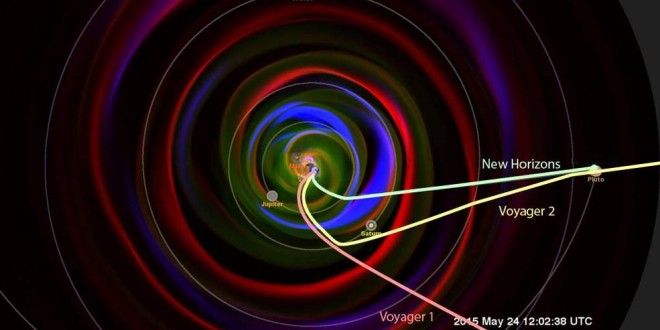Long before the historic flyby of Pluto last summer by the New Horizons mission, the spacecraft was busy collecting reams of data, and a new study resulting from its epic voyage is shedding new light on deep space weather.
NASA scientists have published New Horizons’ observations in a study appearing in The Astrophysical Journal Supplement.
The study revealed, among other things, that particles in the solar wind pick up a singular burst of energy that accelerates them past their original speed. These particles could be the seeds of very dynamic particles known as anomalous cosmic rays.
When these energetic rays journey closer to Earth, they can present a radiation threat to astronauts. Farther out in the Solar System, at lesser energies, the rays are believed to play a part in framing the perimeter where the solar wind hits interstellar space; the area of space Voyager 2 is currently traveling through.
New Horizons measured the solar wind from just beyond the orbit of Uranus until it reached Pluto.
“The instrument was only scheduled to power on for annual checkouts after the Jupiter flyby in 2007,” study author Heather Elliott, a space scientist at the Southwest Research Institute in Texas, said via press release. “We came up with a plan to keep the particle instruments on during the cruise phase while the rest of the spacecraft was hibernating and started observing in 2012.”
This course of action produced three years of almost constant observations of the space in an area where only a few spacecraft have ever flown, much less taken detailed data. The data showed the outer solar system has less complex structures than space closer to Earth, as smaller particle structures are broken down or bunched together as they move out from the Sun, creating fewer and larger features.
“At this distance, the scale size of discernible structures increases, since smaller structures are worn down or merge together,” Elliott said. “It’s hard to predict if the interaction between smaller structures will create a bigger structure, or if they will flatten out completely.”
Now, with data from both the New Horizons and Voyager 2 probes, the study scientists said they have even more data about this distant area of space, which will be important for testing models of how the solar wind moves throughout the solar system.
Agencies/Canadajournal
 Canada Journal – News of the World Articles and videos to bring you the biggest Canadian news stories from across the country every day
Canada Journal – News of the World Articles and videos to bring you the biggest Canadian news stories from across the country every day



